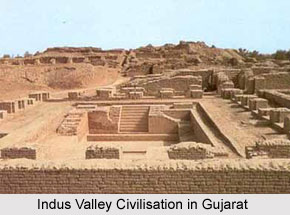 History of Gujarat dates back to the period of Indus Valley Civilization. It comprises an important part of Indian historical texts. The State bears its name from the Gujara which was the land of the Gujjars, who ruled the area during the period of 700`s and 800`s. The state Gujarat has seen different rulers in different times. Many coastal cities of Gujarat served as a port and trading center for Nanda, Maurya, Satavahana and Gupta empires. After the decline of Gupta Empire in 6th century, Gujarat became an independent Hindu and Buddhist site. During 10th century Chalukya dynasty and during 18th century Maratha Empire took control over the state. After British Raj, in 1960 Gujarat was formed by splitting Bombay (now Mumbai).
History of Gujarat dates back to the period of Indus Valley Civilization. It comprises an important part of Indian historical texts. The State bears its name from the Gujara which was the land of the Gujjars, who ruled the area during the period of 700`s and 800`s. The state Gujarat has seen different rulers in different times. Many coastal cities of Gujarat served as a port and trading center for Nanda, Maurya, Satavahana and Gupta empires. After the decline of Gupta Empire in 6th century, Gujarat became an independent Hindu and Buddhist site. During 10th century Chalukya dynasty and during 18th century Maratha Empire took control over the state. After British Raj, in 1960 Gujarat was formed by splitting Bombay (now Mumbai).
Ancient History of Gujarat
The Gujjars were the first settlers in the State of Gujarat. During the period of the Huna invasion the clan appeared in northern India and in Saurashtra. However, the earliest Archaeological traces specify the Indus Valley Civilization as historical relics. Its roots were also found in the Harappan traces at Lothal, Rampur, Amri and other places. The Maurya Empire ruled the ancient Gujarat. The dynasty under Emperor Chandragupta Maurya conquered a number of states in Gujarat. His grandson, King Ashoka later extended his domain in Gujarat. The state also witnessed the Greek invasion in Gujarat under the rule of Dernetrious. The state was next ruled by the Shunga Dynasty who tried to uphold the semblance of political unity. After the fall of the Maurya Empire from 130 to 390 A.D. the Sakas or Scynthians ruled the region. It was again during the 900s that the state went into the hands of the Solanki Dynasty. Under the Solanki Dynasty, Gujarat reached to its peak stage. Later Gupta Empire took control over the state, which was declined during 6th century.
 Medieval History of Gujarat
Medieval History of Gujarat
During the Medieval Period the Muslim rule sustained for almost 400 years. Mahmud of Ghazni was the first Muslim conqueror. Later Gujarat`s Muslim governor Zafar Khan Muzaffar affirmed his independence and thus established the first Muslim sultanate in Gujarat. Later, Ala-ud-din Khilji invaded Gujarat in 1298 A.D. In 1576 the Mughal emperor Akbar conquered Gujarat. The Mughals ruled for the next 2 centuries until the Marathas under Chhatrapati Shivaji conquered it in the mid 18th century.
Modern History of Gujarat
The modern history of Gujarat began with the advent of the Portuguese rule who established their bases along the coast. They built several enclaves along the Gujarat coast including Daman and Diu. In 1614 the British East India Company established a factory in Surat. During the second Anglo-Maratha War the British annexed much control from the Marathas.
Under Mahatma Gandhi and other freedom fighters India finally gained its independence in 1947. Gujarat became a place for some of the most popular revolts, including the Satyagraha in Kheda, Bardoli, Borsad and the Salt Satyagraha.
Post Independent Gujarat
After gaining independence in 1947, the Indian National Congress party (INC) ruled the Mumbai state. Congress continued to govern Gujarat after the state`s creation in 1960. Gujarat has had 14 different Chief Ministers since its formation in 1960. Dr. Jivraj Narayan Mehta of Indian National Congress was the first Chief Minister. In the 1995 the Congress lost to the BJP and Keshubhai Patel came to power. In 2001 Keshubhai Patel resigned and yielded power to Narendra Modi. He served since 7th October 2001 up to 2014. On 1st June, 2007, Narendra Modi became the longest serving Chief Minister of Gujarat till now on.



















